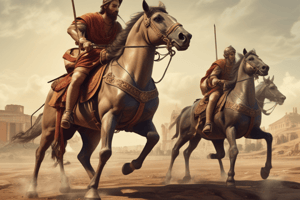Podcast
Questions and Answers
¿Cuál era la principal fuente de ingresos en la economía del Imperio Romano?
¿Cuál era la principal fuente de ingresos en la economía del Imperio Romano?
- Comercio
- Conquista y expansión
- Agricultura (correct)
- Minería
¿Qué fue una de las formas en que los romanos adquirían esclavos?
¿Qué fue una de las formas en que los romanos adquirían esclavos?
- Herencia
- Conquista (correct)
- Matrimonio
- Comercio
¿Qué trabajo hacían los esclavos en las minas y canteras?
¿Qué trabajo hacían los esclavos en las minas y canteras?
- Comercio
- Trabajo doméstico
- Agricultura
- Minería y construcción (correct)
¿Cuál era el estatus legal de los esclavos en la antigua Roma?
¿Cuál era el estatus legal de los esclavos en la antigua Roma?
¿Cuál era una forma en que algunos esclavos pudieron alcanzar la libertad?
¿Cuál era una forma en que algunos esclavos pudieron alcanzar la libertad?
¿Cuál era el papel de los esclavos en la economía del Imperio Romano?
¿Cuál era el papel de los esclavos en la economía del Imperio Romano?
¿Qué infraestructura apoyaba la economía del Imperio Romano?
¿Qué infraestructura apoyaba la economía del Imperio Romano?
¿Cuál fue un castigo común para los esclavos en la antigua Roma?
¿Cuál fue un castigo común para los esclavos en la antigua Roma?
¿Qué posición pudieron alcanzar algunos esclavos liberados?
¿Qué posición pudieron alcanzar algunos esclavos liberados?
Flashcards are hidden until you start studying
Study Notes
Economy of the Roman Empire
- The Roman Empire's economy was based on agriculture, trade, and conquest.
- Agriculture was the primary source of income, with large estates (latifundia) producing crops and livestock.
- Trade was significant, with the Roman Empire being a major hub for goods from across Europe, Asia, and Africa.
- Conquest and expansion allowed for the acquisition of new resources, including gold, silver, and other precious metals.
- The Roman Empire's economy was also supported by a vast network of roads, bridges, and aqueducts, which facilitated trade and communication.
Slavery in Ancient Rome
- Slavery was a significant institution in ancient Rome, with an estimated 2-3 million slaves during the 1st century AD.
- Slaves were acquired through conquest, trade, and breeding.
- Slaves performed a variety of tasks, including:
- Domestic work: cooking, cleaning, and serving in wealthy households.
- Agricultural work: farming, harvesting, and tending to livestock.
- Mining and construction: working in mines, quarries, and building projects.
- Commercial work: working in shops, markets, and businesses.
- Slaves were considered property and had no legal rights.
- However, some slaves were able to:
- Gain freedom through manumission (release by their owner).
- Rise to positions of power and influence, such as becoming wealthy merchants or even high-ranking officials.
- Slaves were often treated harshly, with punishments including:
- Flogging and branding.
- Imprisonment and forced labor.
- Sale to gladiatorial schools or forced into prostitution.
Slavery and the Roman Economy
- Slaves played a crucial role in the Roman economy, providing a significant source of labor.
- The availability of slave labor allowed Roman citizens to focus on other pursuits, such as governance, trade, and the arts.
- The slave trade was a significant industry, with many Romans making a living by buying, selling, and trading slaves.
- The Roman economy was heavily dependent on slave labor, and the decline of the slave trade contributed to the decline of the Roman Empire.
Studying That Suits You
Use AI to generate personalized quizzes and flashcards to suit your learning preferences.





